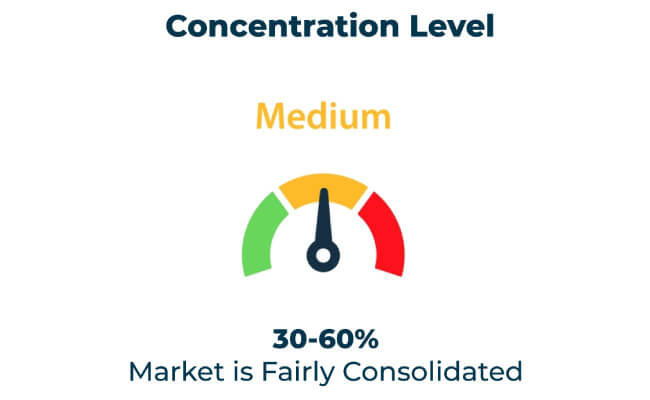The industrial chemical packaging market is rising as businesses look for innovative, durable, and sustainable solutions for storage and transportation. Manufacturers are designing packaging systems that will protect chemicals, ensuring compliance with strict safety and environmental standards. By 2035, this market is expected to exceed USD 213.6 billion, at a compound annual growth rate (CAGR) of 4%.
The shift towards greener packaging materials, coupled with new designs and manufacturing improvements, is leading to increased demand. Companies have been focusing on offering customizable high-performance solutions which cater to the unique challenges posed by chemical handling and distribution. They work in partnership with key industries to ensure the products meet both regulatory requirements and market expectations.
| Attribute | Details |
|---|---|
| Projected Value by 2035 | USD 213.6 billion |
| CAGR (2025 to 2035) | 4% |
Factors Driving Market Growth
| Category | Market Share (%) |
|---|---|
| Top 3 Players (Mauser Group, Greif, Schutz) | 15% |
| Rest of Top 5 Players (Berry Global, Hoover Ferguson) | 09% |
| Next 5 of Top 10 Players | 07% |
Type of Player & Industry Share
| Type of Player | Market Share (%) |
|---|---|
| Top 10 Players | 31% |
| Next 20 Players | 42% |
| Remaining Players | 29% |

Emerging markets in Asia-Pacific, Africa, and Latin America offer incredible opportunities for exports. Rapid industrial growth in these regions, combined with a growing focus on sustainability, is driving demand for durable and environmentally friendly chemical packaging. Exporters can thrive by building strong partnerships with local businesses and working alongside governments that are championing green initiatives. These collaborations not only open new doors but also help meet the rising demand for eco-conscious solutions in these fast-developing markets.
| Region | North America |
|---|---|
| Market Share (%) | 30% |
| Key Drivers | Prioritizes safety and environmental standards. |
| Region | Europe |
|---|---|
| Market Share (%) | 35% |
| Key Drivers | Advances in sustainable and energy-efficient packaging. |
| Region | Asia-Pacific |
|---|---|
| Market Share (%) | 25% |
| Key Drivers | Industrial growth and rising environmental awareness. |
| Region | Other Regions |
|---|---|
| Market Share (%) | 10% |
| Key Drivers | Focuses on cost-effective and compliant solutions. |
The industrial chemical packaging market will grow through advancements in sustainability, smart packaging, and lightweight materials. Companies that adopt recycled materials and invest in automation will gain a competitive edge. Expansion into emerging markets and collaboration with global trade partners will open new growth opportunities.
| Tier | Key Companies |
|---|---|
| Tier 1 | Mauser Group, Greif, Schutz |
| Tier 2 | Berry Global, Hoover Ferguson |
| Tier 3 | Schoeller Allibert, Nefab |
The industrial chemical packaging market is evolving rapidly as sustainability, safety, and innovation drive growth. Companies focusing on eco-friendly practices, advanced materials, and global trade opportunities will lead the market. Collaboration with industry stakeholders and advancements in recycling and automation will further solidify their positions.
Key Definitions
Abbreviations
Methodology
This report combines primary research, secondary data, and expert insights. Analysts validated findings through interviews with industry professionals and end-users, ensuring accurate and actionable insights.
The industrial chemical packaging market encompasses the development and production of specialized packaging solutions that protect chemicals during storage and transport. These solutions prioritize safety, compliance, and sustainability to meet the needs of industries worldwide.
Industrial chemical packaging involves containers and materials designed to safely store, transport, and handle chemicals used in industries like agriculture, automotive, and construction.
Sustainability reduces environmental impact, ensures regulatory compliance, and meets growing consumer demand for eco-friendly solutions.
Common materials include high-density polyethylene (HDPE), PET, steel, and fiberboard, chosen for their durability and resistance to chemicals.
Asia-Pacific, Africa, and Latin America are key regions, driven by rapid industrialization and the shift towards sustainable practices.
Smart packaging with sensors, anti-leak systems, and barrier technologies are transforming the industry by enhancing safety and functionality.






Full Research Suite comprises of:
Market outlook & trends analysis
Interviews & case studies
Strategic recommendations
Vendor profiles & capabilities analysis
5-year forecasts
8 regions and 60+ country-level data splits
Market segment data splits
12 months of continuous data updates
DELIVERED AS:
PDF EXCEL ONLINE
Industrial Security System Market Forecast Outlook 2025 to 2035
Industrial Film Market Forecast Outlook 2025 to 2035
Industrial Floor Mat Market Forecast Outlook 2025 to 2035
Industrial Insulation Market Forecast and Outlook 2025 to 2035
Industrial Process Water Coolers Market Forecast and Outlook 2025 to 2035
Industrial Grade Ammonium Hydrogen Fluoride Market Forecast and Outlook 2025 to 2035
Industrial Grade Sodium Bifluoride Market Forecast and Outlook 2025 to 2035
Industrial Evaporative Condenser Market Size and Share Forecast Outlook 2025 to 2035
Industrial Power Supply Market Size and Share Forecast Outlook 2025 to 2035
Industrial Crystallizer Market Size and Share Forecast Outlook 2025 to 2035
Industrial Counterweight Market Size and Share Forecast Outlook 2025 to 2035
Industrial Gas Market Size and Share Forecast Outlook 2025 to 2035
Industrial Furnace Market Size and Share Forecast Outlook 2025 to 2035
Industrial Weighing Equipment Market Size and Share Forecast Outlook 2025 to 2035
Industrial Drum Market Size and Share Forecast Outlook 2025 to 2035
Industrial Food Slicers Market Size and Share Forecast Outlook 2025 to 2035
Industrial Printer Market Size and Share Forecast Outlook 2025 to 2035
Industrial Fryers Market Size and Share Forecast Outlook 2025 to 2035
Industrial Paper Sacks Market Size and Share Forecast Outlook 2025 to 2035
Industrial Adhesives Market Size and Share Forecast Outlook 2025 to 2035

Thank you!
You will receive an email from our Business Development Manager. Please be sure to check your SPAM/JUNK folder too.
Chat With
MaRIA